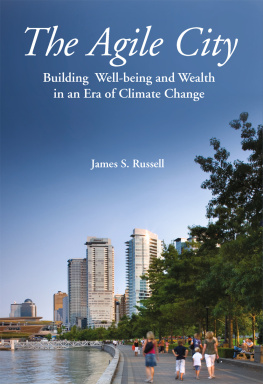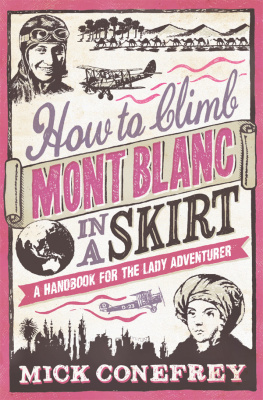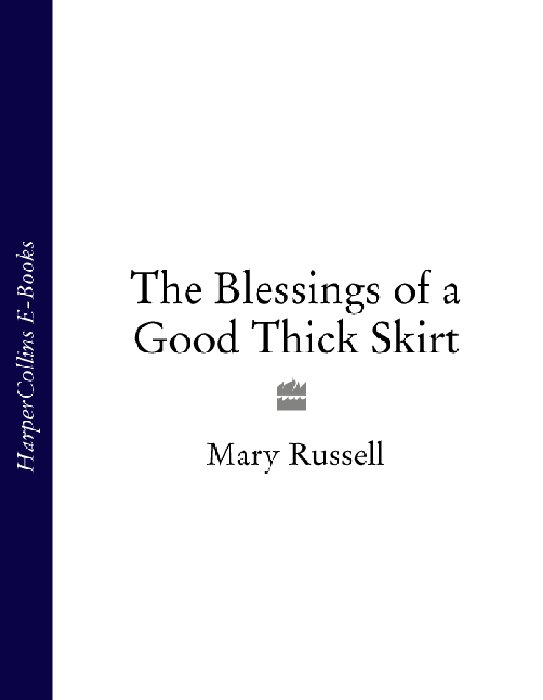MARY RUSSELL
The Blessings of
a Good Thick Skirt
Women Travellers and their World

For Freya, Deirdre and Russell
In memory of their father,
Ian Rodger
It is at these moments you realise the blessings of a good thick skirt save for a good many bruises here was I with the fullness of my skirt tucked under me, sitting on nine ebony spikes some twelve inches long, in comparative comfort, howling lustily to be hauled out.
Mary Kingsley
CHAPTER 1
A Most Excellent Reason
Then the tall cliff was upon us with a splintering crash. The bowsprit snapped like kindling. The flare was out. The night was dark. We clung to the mainsheets in a pool of light thrown by the lamps in front of the wheelhouse. She began to roll from side to side, rails under with incredible speed as if she would roll right over. A colossal jolt, the shock travelled from stem to stern. The mainmast sagged, came over, seemed to hang suspended. The boom dropped and we leapt from under. Before our horrified eyes the bows of the vessel buried into the very face of the cliff.
Husband and wife were thrown into the sea. It was a June night off Portland Bill, but the seas were running fast and cold. They clambered onto their float and watched the flares going up from the cliff. At least they, if not their precious boat, would be saved. Later, miserable and helpless, they watched it break up under the relentless pounding of the waves.
Clinging to the float they saw, with relief, the beam of the lifeboat shining through the giant waves. Suddenly it disappeared as the float, caught by a wave, rose and turned over, throwing them into the sea yet again. By the time they had climbed back in again, the lifeboat had passed, missing them in the dark. With the realization that they were not going to be saved came the icy fingers of fear, plucking at their minds.
Again and again they were thrown into the sea, and with their hands rendered numb and clumsy by the cold, the effort of hauling themselves back into the float became increasingly difficult They were both experienced enough to know how remorseless the sea can be, but by now the battering they were getting had numbed even their minds. Then it happened.
A monster wave rose above the rest. Fury piled upon fury. Curling foaming crest. Sweeping down upon us. Inescapable. I threw an arm around Frank, leant forward. The little float drove into the wall of water and was lost within it. When it broke free, Frank was dead.
For her, there was no such release. Instead, flung again from the float, she was hurled through the sea and washed up onto the rocks, a reject of the gods. The float disappeared and with it the body of her husband. She had lost everything.
In the cold dawn, exhausted and alone, she looked up at the high cliff. Like someone who, having attempted suicide, wakes up to find the nightmare of life still continuing, she was filled with the desperate knowledge that at the top she would have to face again all the problems from which she and her husband had fled when they first set out on their tragic journey. The cliff was sixty feet high. Slowly, she began to claw her way up its crumbling face.
With nothing to sustain her but her courage and her will of iron, she pulled together the torn threads of her life and over the next years began life anew. Survival, however, was not enough. She had a further task to perform the completion of that fatal journey. This second attempt was both an act of homage to her dead partner and, perhaps more important, a personal test of all that had gone before. Although she did something never before achieved by a woman and with minimal resources she remains unknown to most people for she was not a publicity-seeker and her memorable journey was made without the razzmatazz of Fleet Street.
Her name was Ann Davison and in 1953 she became the first woman to sail single-handed across the Atlantic. In a tiny sloop not much bigger than a lorry, she sailed the 3310 miles from Plymouth to Antigua, travelling the last sixty-five days in complete solitude.
To those of us for whom a comfortable bed, running water and the probability of living at least until tomorrow is of prime importance, the phenomenon of the traveller appears as incomprehensible as it is intriguing. Here are people who have succumbed to the treacherous seduction of the unknown, who actually choose to put their lives at risk by climbing the sheer and icy face of an avalanche-ridden mountain; who sail alone in frail craft through towering seas; who will eat maggots and river insects if nothing more palatable is on offer and who can live, day and night for months on end, in the shadow, and the promise, of the unknown.
It is easy to dismiss such people as oddities as indeed they are to be relegated to the bedlam of flat-earthers, freefall divers or indeed writers. That they exist cannot be denied, but the strange, uncomfortable world they occupy lies well outside our everyday experience and can be dismissed, we tell ourselves, as an irrelevancy. We can shrug our shoulders and return thankfully to the twentieth-century world of microwave food and answerphones, glad that the only risks to our own health are the predictable ones of smoking, eating hydrolyzed animal protein or making a kamikaze dash across a city street.
Yet turning away is not enough. There is a residual, nagging curiosity, an invisible thread that pulls us back to seek an explanation. Travellers consciously choose a life of discomfort and danger and somehow their choice of lifestyle is a challenge to our own. We may even harbour the uneasy thought that in so choosing they have acted with more freedom than the rest of us who remain in bondage to the comforts of materialism.
For Ann Davison and her husband Frank, their fatal attempt to cross the Atlantic was a matter of expediency rather than choice, for the wolf, in bailiffs clothing, was at the door. Though pressed unwillingly into this last desperate step, it was a logical result of the precarious lifestyle they had chosen. Almost from the start, they were dogged by financial problems.
They had met when she was a commercial pilot, flying planes in and out of the small aerodrome which he at that time owned. Later, they tried to set up a hill farm and when this ran into difficulties they devised the plan of sailing across the Atlantic and capitalizing on what would undoubtedly have been a great adventure. Before they had time to plan it, however, they found that the bailiffs were intending to impound their boat and, in desperation, they fled, leaving home and debts behind. It was a gamble that failed to come off, but there was no other option the die had been cast a long time ago. They were both adventurous people who could never be content with a nine-to-five existence devoid of challenge. In the air, at sea or out on a lonely, inhospitable hillside, they set themselves tasks the achievement of which took them far beyond the goals aimed at, let alone won, by most people.
The reasons why men and women set themselves the challenge of going beyond the limits of everyday endurance are numerous, complex and mysterious. Few can articulate their motives and fewer still feel it necessary so to do. Their actions speak for themselves. It is usually only after the journey has been completed that travellers will allow themselves the luxury of attempting an analysis, constructing a package of reasons which seem rational and can be presented to the questioner as a sort of peace-offering.
















